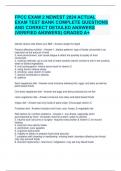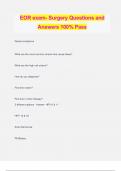FPCC EXAM 2 NEWEST 2024 ACTUAL
EXAM TEST BANK COMPLETE QUESTIONS
AND CORRECT DETAILED ANSWERS
(VERIFIED ANSWERS) GRADED A+
Identify factors that affect your BMI - Answer-weight & height
Factors affecting nutrition - Answer-1. dietary patterns- type of foods consumed is as
important as the amount of food
2. work environment- can cause fatigue & affect the quantity & quality of food
consumed.
3. cooking methods- up to one half of water soluble vitamin content is lost in the cooking
water of boiled vegetables.
4. oral contraceptive- lowers serum level of vitamin C
5. using food to relieve stress
6. smoking- uses vitamin C faster
7. alcohol contributes to obesity
8. caffeine
Semi vegetarian diet - Answer-most inclusive allowing fish, eggs, and dairy as well as
plant based foods
Ovo-lacto vegetarian diet - Answer-eat eggs and dairy products but not fish
Lacto vegetarian diet - Answer-consume only dairy and plant based foods
Vegan diet - Answer-eat only foods of plant origin. Encourage vitamin C
Fruitarian diet - Answer-includes only fruits, nuts, honey, & vegetable oils.
Risk factors for nutrition problems - Answer-1. any illness, especially when
accompanied by fever- increases need for protein, water & calories
2. trauma such as burns or surgery- requires extra protein & vitamin C for wound
healing
3. long term low calorie intake
4. alcoholism- poor appetite
5. cognitive dysfunction
6. inability to obtain or prepare food (food security)
7. problems with chewing or swallowing- missing teeth, disorders affecting the throat.
may only eat soft foods
8. stomach dysfunction- heart burn, indigestion. may eat only bland foods
,9. increased or decreased peristalsis
10. decreased intestinal surface area- decreases absorption of nutrients
11. enzyme secretions
12. bariatric surgery- alters digestion
13. medications
Why is circumference measurement helpful in identifying risks related to obesity? -
Answer-complement to BMI for predicting obesity risk because BMI does not account
for the difference between muscle and fat accumulation
What does a skinfold thickness measure? - Answer-estimates a person's body fat
content. reveals info about current nutritional status as well as long term changes in fat
stores.
What may you see with in a patient with nutritional deficits? - Answer-1. poor skin turgor
2. poor wound healing
3. areas of warmth or erythema
4.red, swollen skin lesions
5. spoon shaped, brittle nails
6. hair will grow slowly
7. lips may be chapped, red or swollen. the tongue may be bright red, purple, or swollen
or may have furrows.
Identify lab values that are indicators of nutritional status - Answer-- Albumin- means it's
a chronic problem
- Pre-albumin means its an acute problem
- Hemoglobin- M- 14-18 g/dL F- 12-16 g/dL
- Iron & TIBC- look at oxygen carrying capabilities in the actual blood stream
- Glucose- 74-106 mL/dL
- Hemoglobin A1C- this is a long term test to see if diabetic patients have their sugar
managed well. Long term glucose control in client
Differentiate among the various sources of nutritional information - Answer-- USDA
dietary guidelines
- Food guide ChooseMyPlate- helps you to have a balanced intake of the 5 food groups.
- DRI's- a list of how many of each nutrient we should be taking in daily, over the long
term
- AMDRs- acceptable macronutrient distribution range- helps with carbohydrates &
lipids & some of the other ranges you need to know about.
Clear liquid diet - Answer-provides fluids to prevent dehydration, and supplies some
simple carbs to help meet energy needs.
Anything that you can hold up to the light & see through:
water, tea, coffee, broth, clear juice (apple, grape, cranberry), popsicles, carbonated
beverages, and gelatin. hard candies may be allowed.
,*No dairy, & no pulp juices because we want minimum residue on this diet.*
once tolerated, can advance to a full liquid diet.
full liquid diet - Answer-contains all the liquids in the clear liquid diets plus any food
items that are liquid at room temperature
add to clear liquid: soups, milk, milk shakes, puddings, custards, juices, some hot
cereals, and yogurt
Mechanical soft diet - Answer-The diet of choice for people with chewing difficulties
resulting from missing teeth, jaw problems, or extensive fatigue.
add to the full liquid: soft vegetables & fruits, chopped, ground, or shredded meat;
breads, pastries, eggs and cheese.
Low residue/low fiber diet - Answer-o usually someone with scaring/ scar tissue/
blockage In the intestinal tract, or diverticuli (a little pouch that sprout out from the
intestine) & it is really easy for things like popcorn, nuts, seeds, to get stuck & trapped in
there, then it gets inflamed & the person ends up with abdominal pain.
Examples that don't have a lot of fiber- white bread, cooked pasta, potato's with no skin,
white rice. Avoid raw fruits, vegetables, nuts, seeds, whole grains, & hopefully this will
pass on the through the GI tract with out any trouble.
High fiber diet - Answer-patient is probably constipated. Anytime we talk about a patient
whether its electrolyte imbalance, or immobility, think about increasing fiber in the diet
which you can do independently. You may have this ordered though.
Renal diet - Answer-Limit salt, potassium (really important to limit this), phosphorus,
calcium, protein because byproducts will start building up that the kidneys cant filter for
us.
Fat restricted diet - Answer-low fat diet. No butters, dairy products. We see clients with
terrible cholesterol who need to watch their butters & fats, need to stick with lean meats
instead of full beef kind of diet. Animal products, eggs, cheese.
Carb consistent diet - Answer-diabetic patients.
find a balance in the amount of carbohydrates they are taking in every meal compared
to whether the body is providing any insulin or if they are completely insulin dependent.
Regular diet - Answer-if your patient has a regular diet ordered, they can eat anything
they want to eat. no restrictions
, How do you "advance diet as tolerated" - Answer-Just start with a few bites of ice chips,
then as that is tolerated you go to clear liquids, then full, then hopefully you can move
fast to a regular diet from there. Mostly based on nausea & vomiting & then the other
signs of comfort, like being bloated or gassy.
Describe nursing interventions for clients with special needs: poor appetite, impaired
taste/smell, impaired swallowing, eating disorders, and nausea. - Answer-1. General
environment- make the environment more pleasant. Remove the emesis basin from the
bedside. Get rid of odors, wipe things down.
2. Food presentation- give hot food hot, cold food cold.
3. Small frequent meals- eat 6 small meals instead of 3 regular meals
4. Decrease fluid intake with meals- if you drink when you eat you might feel fuller.
Encourage the patient to drink between meals instead of during.
5. Social aspect- encourage family to come during meal times, want to make eating as
enjoyable as possible.
6. Nausea- give nausea medicine 30-45 minutes before meal time to suppress the
nausea as much as possible to increase the appetite
Describe techniques for assisting clients with meals. - Answer-1. Positioning- 45
degrees or more, as close to 90 as you can get.
2. flex- have neck down because it is easier to swallow this way
3. Thickeners- the thicker the liquid is, the less likely the patient will be to aspirate.
These make it easier for the patient to swallow correctly & keep it from going into the
airway.
4. Time- allow as much time as needed for the client to finish their food.
5. Suction availably- basic safety, have handy just in case patient does aspirate & you
need to suction it out.
Enteral nutrition - Answer-delivery of liquid nutrition into the upper intestinal tract via a
tube.
it is the preferred method of feeding for a patient who has a functioning GI tract but
needs nutritional support such as those with trauma, burns, or severe malnutrition;
neuro disorders, anorexia nervosa
may be a short or long term therapy
Why are enteral feedings preferred to parenteral? - Answer-they maintain peristalsis &
have a lower incidence of infections.
What are the risks associated with enteral feedings? - Answer-1. if enteral formula is
aspirated in the lungs, it can lead to infection, pneumonia, abscess formation,
respiratory distress syndromes
2. high glucose content provides a medium for bacterial growth
3. NVD, alterations in drug absorption & various metabolic disturbances.





